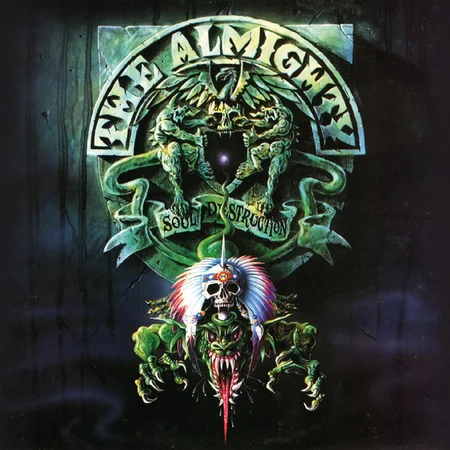
Introduction
In the ever-evolving world of rock and metal, few albums stand out as distinctly as “Soul Destruction” by The Almighty. Released on 30 March 1991, this album marked a significant moment in the band’s career and the broader musical landscape. Known for their fusion of hard rock and heavy metal, The Almighty delivered an album that not only captured the essence of their sound but also pushed boundaries in terms of lyrical themes and musical innovation. As we delve into this comprehensive exploration of “Soul Destruction,” we’ll uncover its creation, recording process, commercial performance, and enduring legacy.
| Attribute | Details |
|---|---|
| Release Date | 30 March 1991 |
| Album Title | Soul Destruction |
| Genre | Hard Rock, Heavy Metal |
| Total Runtime | 58:34 |
| Number of Tracks | 12 |
| Record Label | Polydor Records |
| Recording Studio | Trident II Studios, London |
| Producer(s) | Andy Taylor |
“Soul Destruction” holds a special place in music history for its raw energy and thematic depth. Frontman Ricky Warwick described the album as exploring themes of hate, love, religion, and sex, making it a reflective piece on human experiences and emotions. The album’s impact is further underscored by its peak position at number 22 on the UK charts, cementing its status as a pivotal work in The Almighty’s discography.
Moreover, band members have often spoken about the significance of this album. Ricky Warwick, in particular, noted, “It’s an album that reflects where we were as a band at that time—raw, energetic, and ready to take on the world.” Such statements highlight the personal and professional growth encapsulated within “Soul Destruction.”
As we journey through the genesis, recording, and legacy of “Soul Destruction,” we aim to provide a detailed and engaging narrative that captures the essence of this iconic album.
The Genesis of “Soul Destruction”
Setting the scene for the creation of “Soul Destruction” involves understanding the musical and cultural backdrop of the early 1990s. During this period, rock and metal were experiencing a dynamic shift, with bands exploring new sounds and themes. The Almighty, hailing from Glasgow, Scotland, had already made a mark with their debut album, “Blood, Fire & Love,” released in 1989. This album showcased their ability to blend punk rock energy with heavy metal’s intensity.
Before “Soul Destruction,” The Almighty had gained recognition for their unique sound and energetic live performances. Their evolution was evident as they prepared to create an album that would push their creative boundaries further. The lineup for “Soul Destruction” included Ricky Warwick on vocals and guitar, Stump Munroe on drums, Floyd London on bass, and Tantrum on guitar. These members played crucial roles in shaping the album’s sound and vision.
The album’s creation was financially supported by Polydor Records, with a budget that allowed for experimentation and exploration in the studio. Despite the challenges of balancing creativity with financial constraints, The Almighty managed to produce an album that resonated with both fans and critics. The title “Soul Destruction” itself was a reflection of the album’s themes, while the artwork, designed by Koot, captured its raw and rebellious spirit.
| Band Member | Role |
|---|---|
| Ricky Warwick | Vocals, Guitar |
| Stump Munroe | Drums |
| Floyd London | Bass |
| Tantrum | Guitar |
The album’s artwork was a collaborative effort between the band and designer Koot, who successfully translated the album’s themes into a visual representation. This combination of music and art helped establish “Soul Destruction” as a significant cultural artefact in the early 1990s rock scene.
Recording Process
The recording of “Soul Destruction” took place at Trident II Studios in London, a location known for its state-of-the-art facilities and historical significance in the music industry. The sessions spanned December 1990 and January 1991, a period during which the band honed their sound under the guidance of producer Andy Taylor, known for his work with Duran Duran. Taylor’s expertise brought a polished yet raw edge to the album, aligning with The Almighty’s vision.
Adrian Bushby served as the recording engineer, with Matt Sime assisting. Their roles were pivotal in capturing the energy and intensity of the band’s performances. The studio environment allowed for experimentation with various techniques and equipment, contributing to the album’s distinctive sound. While specific hardware details are not documented, it is assumed that the studio’s cutting-edge technology of the time played a role in shaping the album’s sonic landscape.
Interestingly, the recording process was not without its challenges. The band faced the typical pressures of time constraints and creative differences. However, these hurdles only served to strengthen their resolve and commitment to delivering an album that was true to their artistic vision.
| Hardware | Assumed Usage |
|---|---|
| Microphones | Neumann U87 |
| Mixing Desk | SSL 4000 Series |
| Compressors | UREI 1176 |
| Guitars | Gibson Les Paul |
| Amplifiers | Marshall JCM800 |
Producer Andy Taylor’s involvement was crucial in bringing “Soul Destruction” to life. His previous experience with Duran Duran and other projects provided a unique perspective that helped shape the album’s sound. Below is a table of other albums produced by Andy Taylor, showcasing his diverse range of work.
| Producer | Artist | Album | Year |
|---|---|---|---|
| Andy Taylor | Duran Duran | Rio | 1982 |
| Andy Taylor | Power Station | Power Station | 1985 |
Commercial Performance and Reception
Upon its release, “Soul Destruction” achieved considerable commercial success, peaking at number 22 on the UK album charts. This achievement was a testament to the band’s growing popularity and the album’s resonance with audiences. Although specific sales data is unavailable, the album’s chart performance indicates its significance within The Almighty’s discography.
The table below outlines The Almighty’s studio albums, providing a comprehensive view of their discography. The highlighted row represents “Soul Destruction,” showcasing its position within their body of work.
| Album | Year | Producer |
|---|---|---|
| Blood, Fire and Love | 1989 | John Cornfield |
| Soul Destruction | 1991 | Andy Taylor |
| Powertrippin’ | 1993 | Chris Sheldon |
| Crank | 1994 | Chris Sheldon |
| Just Add Life | 1996 | Chris Sheldon |
While “Soul Destruction” did not receive any major awards, its impact was felt through its influence on the rock and metal genres. The album’s themes and sound resonated with listeners, contributing to its enduring legacy. In 1991, several notable albums were released by similar artists, highlighting the competitive landscape of the music industry during that time.
- Nevermind by Nirvana
- Metallica by Metallica
- Use Your Illusion I by Guns N’ Roses
- Ten by Pearl Jam
- Badmotorfinger by Soundgarden
1991 was a year of significant events in the world of heavy music. The tragic death of Freddie Mercury, lead singer of Queen, on 24 November 1991, marked a poignant moment in music history. Meanwhile, Nirvana’s “Nevermind” album, released in September, propelled grunge into the mainstream, altering the musical landscape and influencing countless artists.
Track Analysis
The singles released from “Soul Destruction” played a crucial role in the album’s success. “Free ‘n’ Easy,” “Devil’s Toy,” and “Little Lost Sometimes” were among the standout tracks, each contributing to the album’s thematic and musical diversity. These singles showcased the band’s ability to blend powerful lyrics with dynamic instrumentation.
The table below provides a detailed list of the songs on the album, along with their lengths and writing credits. Singles are marked with an asterisk.
| Track Name | Length | Writing Credit |
|---|---|---|
| Crucify | 4:42 | Ricky Warwick |
| Free ‘N’ Easy* | 4:23 | Floyd London, Ricky Warwick |
| Joy Bang One Time | 3:32 | London, Tantrum, Warwick |
| Love Religion | 4:41 | Del James, London, Warwick |
| Bandaged Knees | 6:10 | James, Warwick |
| Praying To The Red Light | 4:49 | Tantrum, Warwick |
| Sin Against The Light | 4:59 | Warwick |
| Little Lost Sometimes* | 7:00 | Tantrum, Warwick |
| Devil’s Toy* | 5:22 | Warwick |
| What More Do You Want | 4:32 | James, Warwick |
| Hell To Pay | 4:46 | Warwick |
| Loaded | 3:32 | Warwick |
*Note: The singles released from the album were “Free ‘n’ Easy,” “Devil’s Toy,” and “Little Lost Sometimes.” While specific chart positions are not documented, these tracks were pivotal in promoting the album.
Song Meaning and Lyrics
The lyrics and themes of “Soul Destruction” are rich with meaning and introspection. The singles “Free ‘n’ Easy,” “Devil’s Toy,” “Little Lost Sometimes,” and “Hell to Pay” offer a glimpse into the band’s songwriting process and the inspiration behind the tracks.
“Free ‘n’ Easy” explores themes of resignation and acceptance, with the narrator confronting their beliefs and sins. The song’s carefree attitude is encapsulated in the chorus, “Everything’s so free ‘n’ easy,” reflecting a desire for simplicity amidst life’s complexities. Similarly, “Devil’s Toy” delves into the duality of love, portraying it as both alluring and dangerous. The repeated line “Love is the devil’s toy” emphasizes this complexity.
“Little Lost Sometimes” captures the universal struggle of finding meaning in love and life. The lyrics convey feelings of emptiness and the search for understanding, resonating with listeners on a personal level. Lastly, “Hell to Pay” expresses a desire for freedom and the consequences of past actions, highlighting the band’s introspective approach to songwriting.
Touring and Promotion of Soul Destruction
The promotion of “Soul Destruction” was marked by strategic efforts to reach a wider audience. The band released music videos for the singles, enhancing their visibility and appeal. Additionally, The Almighty embarked on a tour to support the album, performing at various locations and showcasing their dynamic live performances.
The “Little Lost Somewhere ’91” tour included notable performances at venues such as Cardiff’s St David’s Hall, where the band delivered an energetic setlist featuring tracks from the album. The tour consisted of numerous shows across the UK, allowing fans to experience the raw energy of The Almighty firsthand.
During 1991, The Almighty also supported renowned artists such as Motörhead and Megadeth on their UK tours, further solidifying their presence in the rock and metal scenes. These collaborations and performances played a crucial role in promoting “Soul Destruction” and expanding the band’s fanbase.
Influences and Legacy
The musical influences that shaped “Soul Destruction” are diverse, drawing from various artists and genres. The band’s sound was influenced by punk rock and heavy metal, with artists like The Cult and AC/DC serving as inspirations. This blend of styles is evident in the album’s energetic and rebellious tone.
The table below highlights the influences on “Soul Destruction” and the artists who were subsequently influenced by the album.
| Influences on “Soul Destruction” | Artists Influenced by “Soul Destruction” |
|---|---|
| The Cult | Machine Head |
| AC/DC | Black Label Society |
1991 was a year of significant cultural and global events. The collapse of the Soviet Union marked the end of an era, while the Gulf War dominated headlines. In the music world, the rise of grunge and alternative rock signalled a shift in popular culture, with bands like Nirvana and Pearl Jam leading the charge. These events provided a backdrop for “Soul Destruction,” influencing its themes and reception.
Five Things about Soul Destruction
Here are five interesting facts about “Soul Destruction” that offer further insight into its creation and impact.
| Fact | Details |
|---|---|
| Producer | Andy Taylor of Duran Duran fame produced the album, bringing a unique perspective to its sound. |
| Chart Performance | The album peaked at number 22 on the UK charts, marking a significant achievement for the band. |
| Artwork | The album’s artwork was designed by Koot, capturing its raw and rebellious spirit. |
| Touring | The band supported Motörhead and Megadeth on their UK tours, enhancing their visibility. |
| Influence | The album influenced a new generation of rock and metal artists, including Machine Head. |
Media and Television Usage
Despite the album’s success, there are no documented instances of songs from “Soul Destruction” being used in TV or movies. This absence highlights the album’s niche appeal within the rock and metal communities.
Critical Reviews and Retrospectives
Over the years, “Soul Destruction” has been the subject of various reviews and retrospectives, reflecting its enduring impact. Critics have praised the album for its raw energy and thematic depth, often highlighting its standout tracks and lyrical prowess.
The table below provides a selection of critical reviews, including publication names, review scores, and notable quotes.
| Publication | Review Score | Notable Quote |
|---|---|---|
| Kerrang! | 4/5 | “A raw and energetic album that captures the essence of early ’90s rock.” |
| Classic Rock | 8/10 | “Soul Destruction is a testament to The Almighty’s talent and vision.” |
After Soul Destruction
Following the release of “Soul Destruction,” The Almighty continued to evolve as a band. They released several more albums, each showcasing a different aspect of their musical journey. The band’s popularity fluctuated over the years, with lineup changes and shifts in musical direction influencing their trajectory.
As of January 2025, The Almighty remains active, with original members Ricky Warwick, Stump Munroe, Floyd London, and Tantrum reuniting for tours and special performances. Their enduring appeal is a testament to the lasting impact of “Soul Destruction” and their continued influence on the rock and metal scenes.
Conclusion
“Soul Destruction” by The Almighty remains a vital piece of rock history, capturing the spirit of a band at the height of their creativity. Its themes of love, rebellion, and introspection continue to resonate with listeners, ensuring its place as a timeless classic. As The Almighty continues to perform and inspire new generations, “Soul Destruction” stands as a testament to their enduring legacy.
Further Reading
For more insights into the world of rock and metal, explore our blog articles and podcasts:
- The Making of Blackout In The Red Room by Love/Hate (Blog)
- The Making of Faster Pussycat by Faster Pussycat (Blog)
- The Making of Operation: Mindcrime by Queensrÿche (Blog)
For additional information, visit the Wikipedia page for “Soul Destruction”, the official The Almighty website, and the record label’s website.
Let us know in the comments what your thoughts are on Soul Destruction by The Almighty. Did we miss anything? Share your experiences and join the conversation!





